Art & Exhibitions
artnet Asks: Josh Reames on Instagram, Astrophysics, and Kanye West
The artist's work mimics the streams of information we experience online.

The artist's work mimics the streams of information we experience online.

Artnet News

Four large canvases and a six-pack of Heinnieweisse provide a modest setting inside the Bushwick studio of Dallas-raised, Brooklyn-based painter Josh Reames.
The buzzworthy artist has upcoming shows in Milan, London, Mexico, Los Angeles, and Chicago. His works consciously employ commonly used artistic techniques, such as trompe-l’oeil, action painting, graphic design, screenprinting, and rudimentary drawing, all existing on one plane.
His subject matter ranges from floating, technicolored fruits, food labels, and computer graphics to art historical references, like René Magritte’s pipe, paint splatters, and graffiti. Reames’s computer-screen-like canvasses are meant to mimic the idiosyncratic, non-objective streams of information we experience every day, whether it’s online or walking down the street.
In an interview with artnet News, Reames tackles topics like his brief stint in the corporate world, the self-proclaimed artists of Instagram, astrophysics, his upcoming West Coast show, and Kanye West.
What inspires your work, are there any artists that come to mind?
I look up to Sigmar Polke and Albert Oehlen, painters that were/are really paying attention to the minutiae of culture. The Sigmar Polke show at the MoMA was one of the best shows I’ve ever seen. The guy knows how to paint. He’s a really good painter, but he’s not being pretentious with his material. That’s the fire that I’m after—the material that is really ubiquitous. It breaks down the hierarchy of importance. [Gestures to his painting Open for Biz] Neon lights, bad fan-art drawings of Taylor Swift, or cigarettes and psychedelic lines.
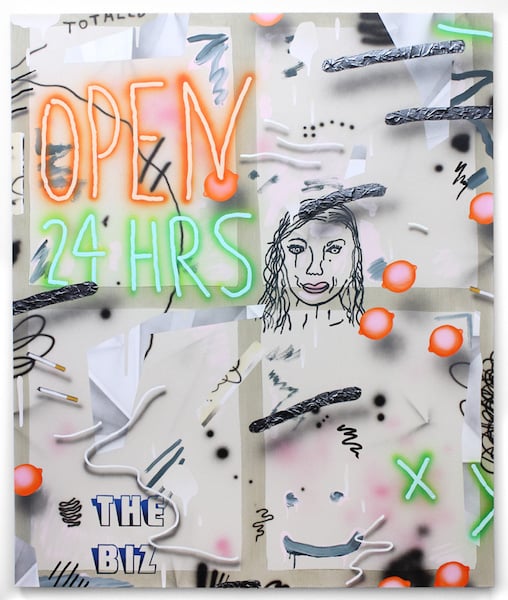
Josh Reames, Open for Biz (2015). Acrylic on canvas. Courtesy of the artist.
What materials do you use?
It’s all acrylic. I use mostly airbrush, and, lately, have gotten back into the classic stick-with-hair brushes, and do as much as I can with them to have a wide variety of mark making. Trompe l’oeil paper, super crisp, hardedge paper, drawings with the airbrush, drybrush, overloaded brush, etc.
How do you decide what to compile? Why group certain images?
They are not related in the narrative sense. One thing that I am really interested in is the way that the Internet—browsing, blog rolling, etc.—takes away the hierarchy of image importance, meaning, and connection. You know, you are scrolling down through articles and headlines, and it will be like “30 dead, suicide bombing in the Gaza strip,” and the next one is a video of a cat, but it’s all equalized on this platform. It’s really weird. I think about painting in a similar way, where images, marks, art historical references, and everyday objects are all depicted on the same level, contained in the same rectangle, emerging out of one painting and into another.
You said your work is tied into the role of the Internet, scrolling through so much information. Do you have an opinion on Instagram—how anyone can technically be an artist these days?
Anyone can be an artist, but it doesn’t mean [their work] is going to be good. It’s easy to make something that will look good on the Internet. Whenever you’re looking at something on a three-inch screen, it looks good. You have to go back to the basics. How is the surface? It is actually a good painting? Do you know what you’re doing? Do you care at all about the craft of what you’re doing? Which brings us back to Polke. All of those test paintings—they’re abstraction. He had a whole series of them where each one was a material plane. Those works could have been made by a really hot young painter right now and everyone would be way into it, but this guy was just testing it out to do something bigger with it and make it more impressive.
You received your degree from the School of the Art Institute of Chicago a few years before Kanye West got his honorary doctorate. How does that make you feel? Do you have an opinion on that?
People can be very dramatic on social media; when I first heard about it, I thought it seemed opportunistic of the school. Then I thought it was pretty badass; now he’s “Honorary Dr. West.” Plus, the school doesn’t even have a PhD program—so what does that mean? I watched his commencement speech and thought it was the most real and down to earth thing I’d ever seen from him. I’m not into his music, but I respect him as a businessperson and as an artist. I can’t even imagine how difficult it would be to put out another album with all the scrutiny.
You worked in the corporate sector for a short time. What was the final push to make you actually pursue art?
I went to school for art as an undergrad, and, after I graduated, I worked as a sales director for a big audiovisual company. My schedule was structured around a typical workweek. At the time, I lived in an old farmhouse where I had a good-sized studio. That’s when I actually started painting. With a tighter schedule, I needed to work with materials that were more immediate. That was a crucial shift for me, because before that I was focused on printmaking.
Working in another industry created a huge divide in my life. I had always intended to pursue art, but I didn’t want to go to grad school right away. The drive was always there; sometimes, you just have to be practical.
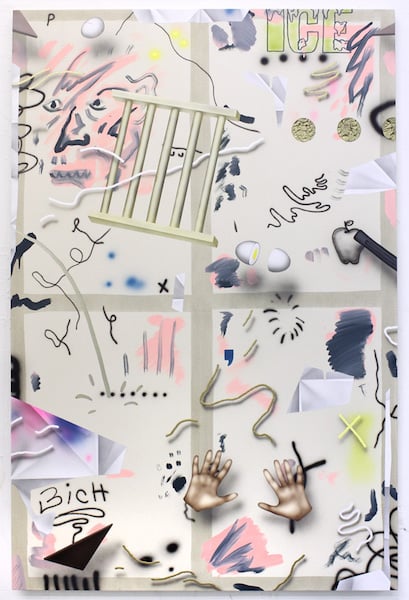
Josh Reames, Jail (2015). Acrylic on canvas. Courtesy of the artist.
If you had to change professions again, what would you do?
Can I be good at math? If so, I would go into astrophysics.
Does that tie into anything you do now?
Lately, not as directly. When I was in grad school, I made a bunch of work using cosmic imagery. The whole reason that stuff interests me is that it’s a branch of science where people are invested in pushing, learning, and fact solving, but at the same time, there’s so much mystery and so much to do with the sublime and the unknown. I think that’s extremely captivating in the same way that I feel art is. I want to paint to see what the next thing will look like.
Tell us about your next show.
There’s a show with Luis (Luis De Jesus), a group show called “HA HA! Business.” My take on it is trying to gather a group of artists who are employing humor, but in a misleading, kind of dry way.
I’m also in a group show at Andrew Rafacz Gallery in Chicago, another group show at Anonymous Gallery in Mexico City, and a three-person show coming up at Josh Lilley Gallery in London.
These paintings I’m making are actually for Luis [points to two paintings on the wall]. I’m making one more, using the same background image, and they’re going to be called West, Wester, and Westest. So, it’s alternating as a tryptic.
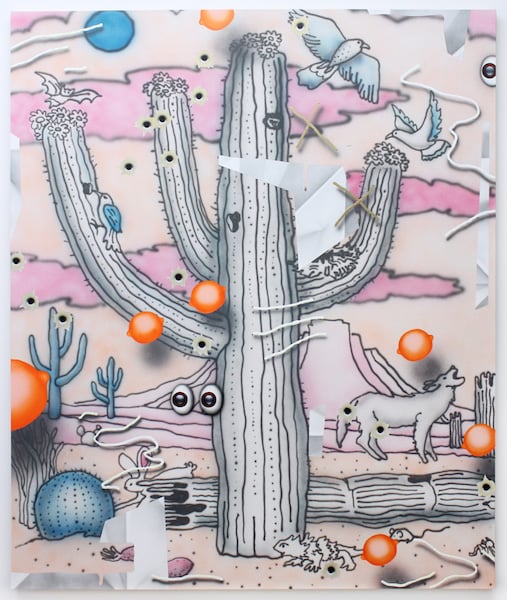
Josh Reames, West (2015). Acrylic on canvas. Courtesy of the artist.
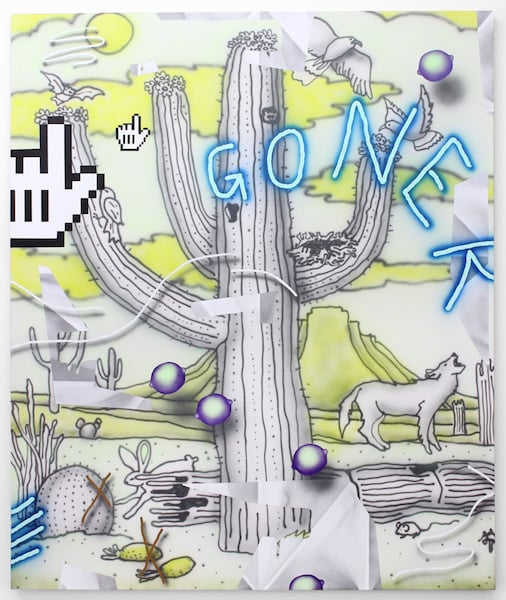
Josh Reames, Wester (2015). Acrylic on canvas. Courtesy of the artist.
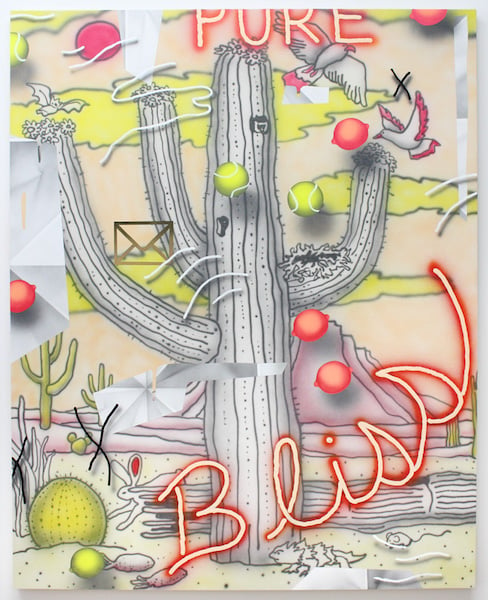
Josh Reames, Westest (2015). Acrylic on canvas. Courtesy of the artist.